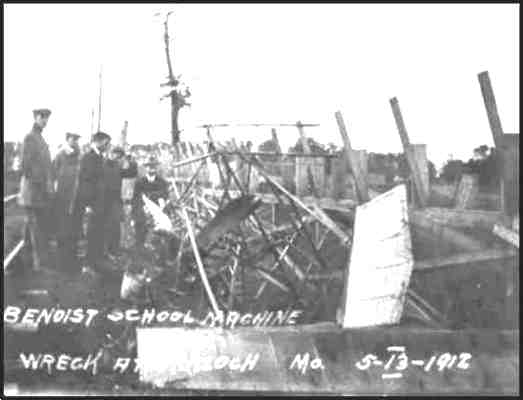

|
| RAY BENEDICT JOHNSON WALTER LEES EISLER. |
| One day, Pete Blazer and a friend took out a Benoist pusher plane without
permission. When they were coming in for a landing, they hit some high tension wires. They crashed, the plane burned, and both of
them were killed. May 13, 1912. Walter wrote: "It was devastating. We were all used to crashes, but because we flew at such low speed and altitude, few of them were fatal. This was a shock to the entire crew at Benoist. I spent a few days debating whether to quit the flying game altogether or not" Walter was anything but a quitter. He went to work in the Benoist shop building wooden propellers. One-half to three-fourth inch thick spruce boards were cut and planed. One board was laid down, hot glue applied, then another board, and more hot glue applied until the required thickness was obtained. Many clamps were put on and screwed tight and it was left to dry in a hot room. Then the propeller was finished by hand. At this time, Benoist was only building two types of planes, a pusher biplane with a 75 HP Roberts two cycle engine and a tractor biplane with a Roberts engine. The tractor fuselage was made of plywood, a box affair, about 15 inches square. The pilot sat up above the fuselage with no windshield. This pusher biplane had two side-by-side seats, individual sticks for elevator and ailerons, and a large wheel between the seats for rudder control. The control surfaces were not hinged at the front, but fixed so they would warp. A steel band from the front edge to the rear of the wing was fastened along the fore and aft ribs. Cables running from the cockpit to the top and bottom of the controls moved or warped the surfaces. This method was also used on the tractor planes. The Benoist controls had one stick in the middle for control of elevators and ailerons, and another stick on the left side to control the rudder. You pulled back for left turns and pushed forward for right turns. The engine was controlled by your right foot on a foot pedal that was in a hole in the bulkhead between the front and rear seat. The only instrument was an oil guage. The Roberts engine had a carburetor on the right side, which fed gas into a rotary valve extending the full length of the engine. Portholes in the valve were spaced to feed gas into each cylinder, and gas was mixed with lubricating oil in the tank. "Roberts recommended one quart of oil to five gallons of gas, but Tony Jannus found that two quarts of oil to five gallons was better as it prevented the round rotary valve from sticking. We had to adjust the carburetor by hand before each flight." To check RPM's (revolutions per minute), the plane was tied down and two men stood in front of the engine. The one nearest the engine would hold a revolution counter against the end of the propeller shaft. The second man would grasp onto the free hand of the first man to keep him from being sucked into the propeller when the throttle was opened and the engine revved up. With the fixed propellers used in 1912, RPM's were a direct measure of the amount of power being developed by an engine. If the engine did not develop enough propeller RPM's. the engine was not generating enough horsepower and the airplane simply would not fly. To get thrust or engine pull, the two skids on the landing gear were put on rollers. The wheels were taken off, a pull scale fastened to the tail skid, and the engine revved up full. Then a reading was taken on the scale. At Kinlock, Walter met many flyers, who later became famous. Among them was Eddie Stinson. "He was a ragged pants kid at that time." Walter said. (Stinson started the Stinson Airplane Company in 1926.) 

|